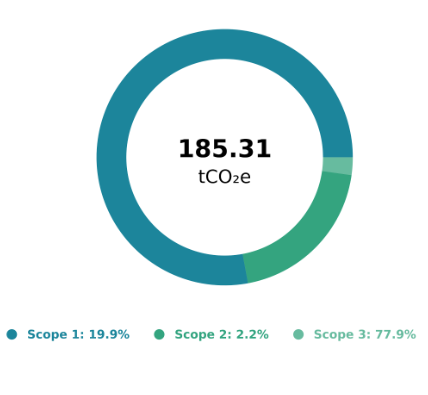
Willing to combine climate expertise with technology, Kazidomi found in Tapio the perfect solution to meet its needs
Combining technologies with climate expertise was essential for Kazidomi. Thanks to Tapio’s toolbox, the platform of sustainable products could better understand its impact. It now knows where to act and which solutions to implement to mitigate its carbon footprint and contribute to global carbon neutrality.

In a nutshell
Kazidomi is a Belgian e-commerce of healthy and sustainable products located in Brussels. The platform is willing to accelerate the transition to healthier and planet-friendlier consumption patterns and ultimately aim for carbon neutrality. To fulfil these ambitions, it ordered a first carbon report in 2020 and a second in 2021. Let’s deep dive into Kazidomi’s climate journey and see how Tapio managed to meet its ambitions.
Starting point
According to a roadmap conducted by the Belgian Institute of Consulting and Studies in Sustainable Development (ICEDD), the CO2 emissions of the agri-food industry would amount to 2.864 k Tons by 2050 compared to 1,210 k Tons in 2005 if agri-food companies do not take any CO2 control measures. Similarly, as established by Capagro and Early Metrics’ White Paper, the startup ecosystem will play a central role in the decarbonization process of the agricultural and food industry.
Kazidomi’s ambitions are directly in line with the objectives mentioned above. Putting sustainability at the heart of its preoccupations, the e-commerce platform seeks to accelerate climate transition by combining new ways of consumption and the respect of people’s health and the planet. It also wants to provide transparency to its customers and stakeholders about its emissions. For Kazidomi, choosing sustainable suppliers is becoming essential to create a low carbon ecosystem. And to reach this objective, combining climate expertise with technology appeared essential as mentioned by Emna Everard, Kazidomi’s CEO & Founder, who also confessed that Tapio’s toolbox had perfectly met the platform’s needs.
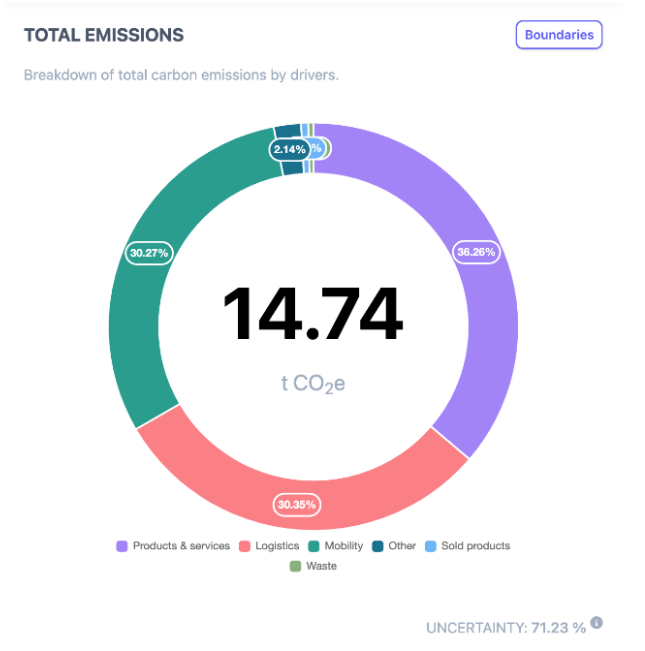
Results analysis
At first, Kazidomi decided to exclude emissions linked to the production given all the various products’ origins and the lack of emission information due to the various providers sometimes located in foreign countries. Working with Tapio experts made them realise that emissions associated with production will represent a huge part in their total carbon report. That is why the e-commerce platform now aims at progressively including in its 2022 carbon report their complete range of products. After 2 years with Tapio, the person in charge of collecting data knows what information will be needed and has foreseen the process to collect it.
Tapio’s data collection tool allowed Kazidomi to have a visualisation of its main emissions sources. These account for 185,31 tCO2e and represent the equivalent of 18 trips by car around the world, 8423 times the amount of emissions a tree annually absorbs and 78 round plane trips between Brussels and New-York. As illustrated down below, Kazidomi’s main emission sources are associated with upstream and downstream logistics, accounting for 40% of the platform’s total emissions. The other emission sources are associated with energy consumption (26%), mobility (25%), waste (6%), and capital goods (2,5%).
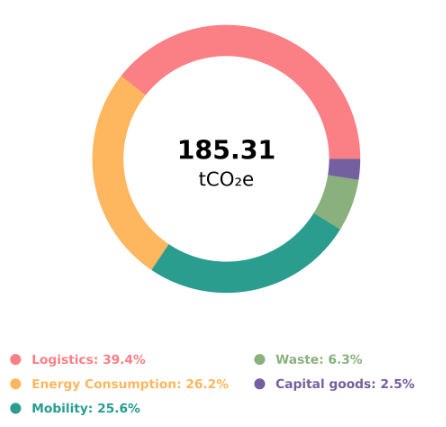
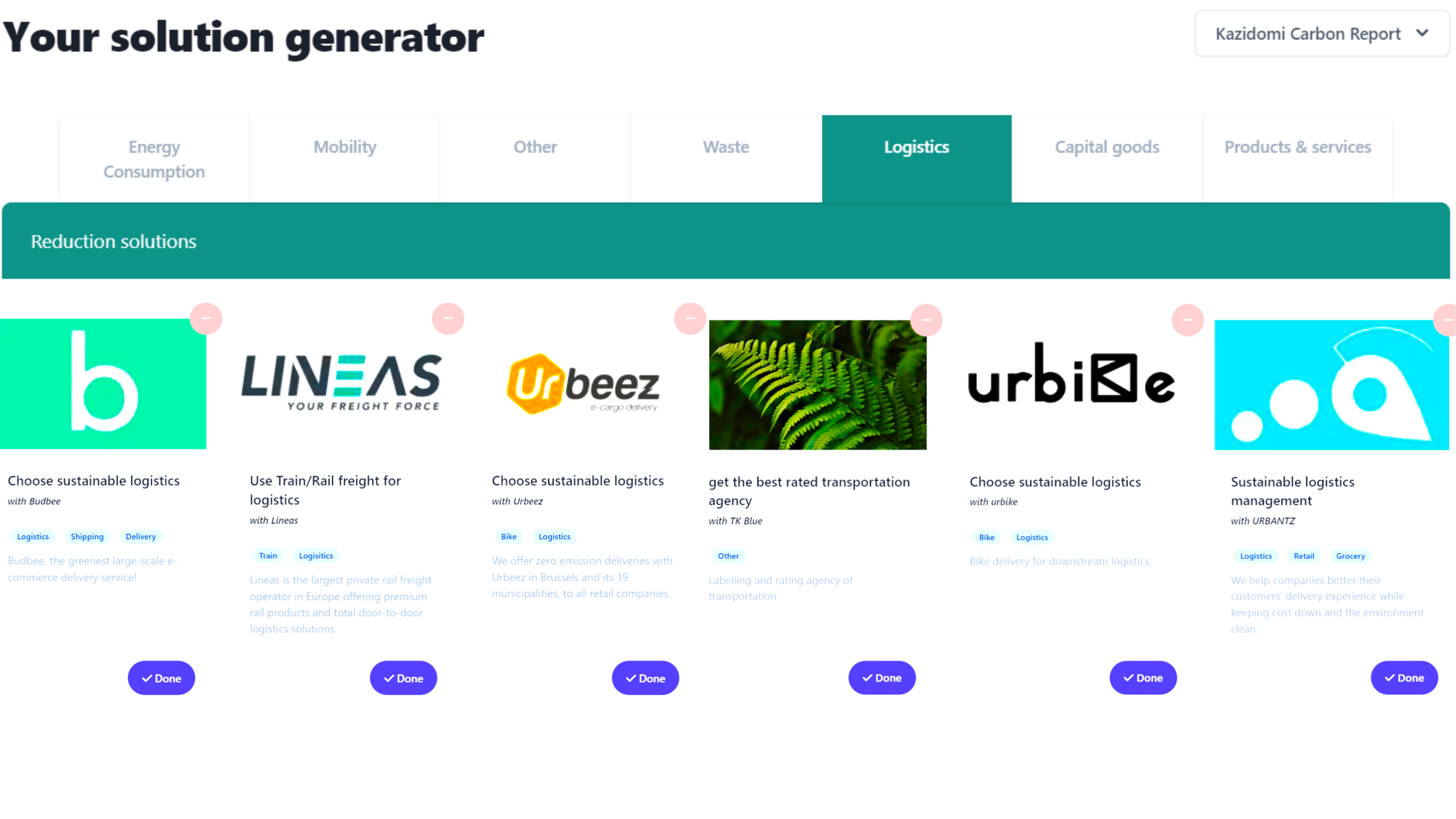
In terms of scopes, Kazidomi is directly responsible for their Scope 1 and Scope 2 emissions. Emission sources related to Kazidomi’s activities, but whose emissions do not occur within the organisational perimeter are included in Scope 3. You can learn more about the different scopes and the emissions they cover by reading our article.
As illustrated in this graph, most of these emissions fall under Scope 3, followed by Scope 2 and Scope 1. Diving more into the details, some emissions are separated between different scopes. For example, out of the 25% of mobility emissions, the part associated with the emissions emitted by the company’s cars falls under Scope 1 while the other associated with the commuting emissions falls under Scope 3. Same conclusion for energy consumption’s emissions whose sources are divided between heating from Scope 1 and electricity from Scope 2. Logistics, waste, and capital goods emissions fall completely under Scope 3 emissions.

In a nutshell, thanks to Tapio’s expertise, Kazidomi’s objectives are now clear: reducing the energy consumed in the warehouses, the modes of transport (both logistics and commuting) as well as the waste generated from orders.
In a nutshell, thanks to Tapio’s expertise, Kazidomi’s objectives are now clear: reducing the energy consumed in the warehouses, the modes of transport (both logistics and commuting) as well as the waste generated from orders.
Solutions by Tapio
Besides the visualisation of its main emission sources, Tapio’s toolbox also provided concrete suggestions to reduce these. As emphasised by Alain Etienne, CEO and Co-Founder of Kazidomi, the tool has allowed him to easily simulate the impact of switching from a combustion vehicle to an electric vehicle which is a strong incentive to make decisions quickly. More concretely, Tapio suggested Kazidomi to launch a broad-scale communication and raise-awareness campaign by displaying CO2 emission on each order sent to its consumers. This echoes Kazidomi’s wishes to pay more attention to the origins of the imported and sold products by rather going for European and more local products instead of the ones coming from abroad. The online store already took measures to reduce its impact by recently isolating its headquarters and also plan to place sun panels for its offices thanks to its collaboration with Skysun.
The reduction of logistics emissions remains the big challenge ahead. For example, the implementation of electrical solutions on all supply vehicles would be barely feasible since the company has mainly recourse to lorries. Nevertheless, Kazidomi has already a partnership with Shippr to reduce emissions on the Last Mile (distance between the warehouse in Brussels to the consumer’s home).
To encourage the platform to keep reducing its carbon footprint on the Last Mile, Tapio came up with personalised solutions that immediately caught Kazidomi’s attention. One of them is the rail freight to supply goods in France through Lineas, which Kazidomi did not have thought of before. Similarly, Urbeez was also part of Tapio’s solutions and includes switching to electric vans or bikes.
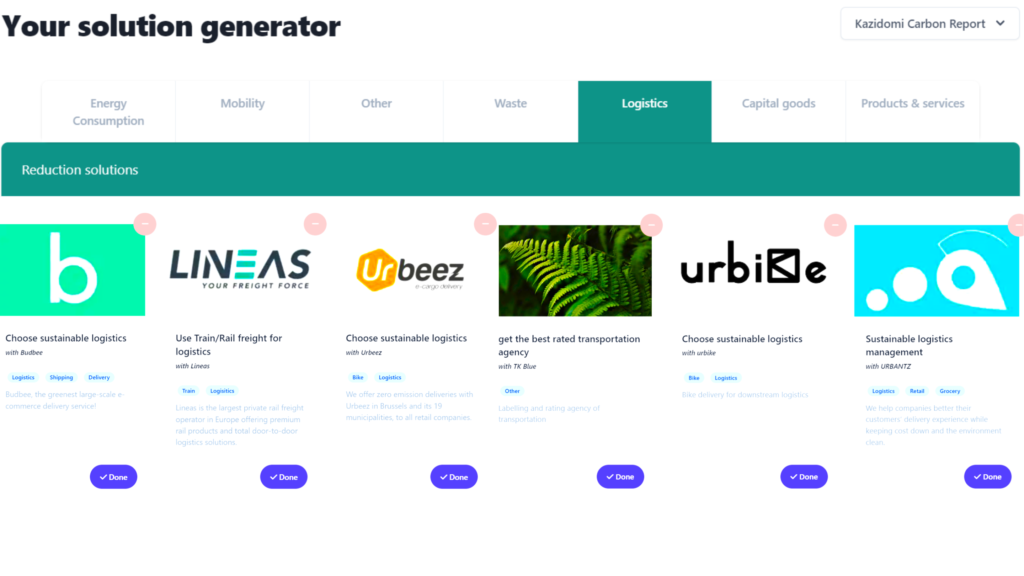
Regarding the emissions associated with mobility, Kazidomi strives to change its employees’ commuting habits. It already uses the HR platform Mbrella that fosters a customised mobility plan for companies’ employees. Similarly, Tapio also suggested Kazidomi to partner up with Lizy which would allow it to get all its cars into electric leased cars, and so, reducing its emissions linked to the company’s cars.
Engagement
Despite its growth, Kazidomi managed to better understand its impact and reduce it. As far as possible, the platform has continued its efforts to stop ordering products from outside Europe and to favour the sourcing of local Belgian and French brands. Eventually, thanks to Tapio’s expertise, the platform was able to reduce its carbon emissions by 13,59% in the first year.
Kazidomi also chose to neutralise its emissions that could not be reduced in the past and selected in 2020 two sequestration projects. The first one is the Lacandon Forests for Life project in Guatemala whose objective is to control among others illegal timber extraction and to ensure the legality of land use through sustainable forest management. The second one is the COMACO Landscape Management Project in the Republic of Zambia. This regenerative agricultural project aims at promoting sustainable agriculture and forest conservation.
These projects allowed Kazidomi to neutralise the equivalent of 214t CO2. However, the platform remains focused on its main objective: the reduction of its carbon emissions. As emphasised by Kazidomi’s co-founder Alain Etienne, reduction progress should not be just a figure you look at once a year. A regular communication towards partners and stakeholders on Kazidomi’s progress in terms of carbon reduction is fundamental to encourage people to act. Eventually, he can easily answer questions regarding sustainability by being fully transparent about its results using the Kazidomi Carbon Strategy Page powered by Tapio.

« Our goal is to have the least possible impact on the planet in order to contribute to achieving global carbon neutrality. »
Alain Etienne, Co-Founder at Kazidomi
If you ended up here, you might think about starting your climate strategy. Now that you have seen how Kazidomi is working with us, let’s talk. If you are still searching for an answer, you can already estimate your carbon impact or get an estimate of the price that fits your profile and your current needs.
Sources:
- Stratégie Carbone de Kazidomi, Tapioview, available at: https://www.tapioview.com/kazidomi/carbon-strategy-page/3885/
- “Vers une industrie alimentaire bas-carbone à l’horizon 2050” FEVIA, September 21, 2017, available at: https://www.fevia.be/fr/actualites/vers-une-industrie-alimentaire-bas-carbone-lhorizon-2050 (Accessed on November 15, 2022).
- “Décarbonation du secteur agroalimentaire : le livre blanc”, BPI France, August 16, 2021, available at: https://www.bpifrance.fr/nos-actualites/decarbonation-du-secteur-agroalimentaire-le-livre-blanc (Accessed on November 14, 2022).